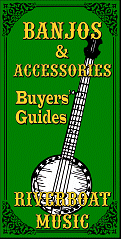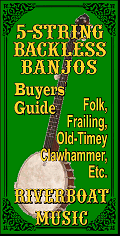Acoustic Instrument
Primers
What Kind of Guitar
Should I Start On?
What Kind of Banjo
Do I Want?
Evaluating and
Buying Used
Guitars
Setting Up
Fretted Instruments Whatever Happened
to the Banjo?
Beginning Five-
String Banjo
6-String Banjos
Banjo Pickups
Axes in my Life
What is a
Bluegrass Banjo?
Dean "Backwoods
Six" Shootout
Music Theory
Primers
Introduction
to Scales
Introduction
to Chords
Circle of Fifths
Other Articles
About Music
How to Give
Guitar Lessons
Musician or
Wannabe? Did God Really
Give Rock &
Roll to You?
Are You a
"Brand Bigot"?
Who Owns Folk Songs?
Historical Links
About the
National Road
The Story Behind
the Story - Real
People, Places,
and Events
About the Play
Play Home
What's New
Overview
About the
Music
About the
History
About the
Logistics
About the
Cast
Synopsis
About the
Set
About the
Author
Contact Us
Home



|

|

5-String Banjo Songs from Creek Don't Rise(tm)
| Written by Paul Race for Creek Don't RiseTM and School Of The RockTM |
There are mp3 clips and accompaniment arrangements for most of the songs, and banjo solo arrangments for a few. Each arrangement includes sheet music and tablature of a sort; many have other materials to help you "get your head around" unusual bits.
In truth, if you work your way through the tutorials, you'll find most of these songs easy to pick up, but I want to provide a "path" for folks who are just looking for specific songs as well.
Notes About My Tablature - I am using Cakewalk Sonar in my home studio. I use it for a lot of other stuff at which it excells. Unfortunately, it does NOT excell at creating printable sheet music or tablature. However, I don't have time to use multiple programs for these, and it does allow me to create little mp3 files quickly so you can hear chords sounds, "roll" patterns, and whole songs as they're discussed - often as many as six separate sample files per song.
Sonar also allows me to create a sort of tablature, with a few differences from tablature that you'll see in other publications and web pages. I'm going to explain these differences up front, so I don't have to explain them again and again later.
If you think this explanation is "overkill" or a waste of readers' time, you've never operated a massive web resource where you gave away thousands' of hours of your own work to help strangers learn esoteric content quickly, and then gotten slammed with e-mails or abused on public forums because you didn't format those resources exactly the way some troll thought you should have.
If you want to learn these songs, and especially if you want to learn to play them on the 5-string banjo, you'll notice that the following accommodations are relatively minor, and they won't be a hindrance to anyone who really wants to learn.
- Sonar does NOT allow me to put little banjo chord symbols above the staff. Sonar permits this for guitar, but they don't see it as a priority for banjo. Sorry.
- Sonar does NOT allow me to put letters such as T, I, H, S, and B under the tab line (to indicate which finger you use to pick individual notes). Sonar doesn't permit this for guitar, either, if that's any consolation. Sorry. I try to put H, S, and P under the music staff where "hammering on," "sliding," or "pulling off" is recommended. And when I have time, I sometimes add those under the fret bar of the .gif version that gets displayed on the page. Again, once you're halfway used to this stuff, you'll have a pretty good idea how and where to use those techniques, anyway.
- In addition, I realize that not everybody plays banjo exactly the same way I do, so:
- I leave out most of the little indicators like T, I, and B that are supposed to tell you which finger (or which part of which finger) to use to pick each note. If you can play a basic "bum-ditty" banjo roll in any style, most of those indicators are superfluous anyway, if not outright confusing.

- On the part of the beat that traditional banjo players typically play more than one note (say, with the back of their fingernails), I put multiple notes on the staff. If you're a frailer or a four-finger picker, this won't pose a threat. If you're a three-finger ("Scruggs") picker, you will need to experiment and decide which of the notes on the staff will sound best to you, especially on the solo tabs.
If that makes no sense, check out lesson 2 of our free online banjo tutorial for a more detailed explanation of this issue.
- I leave out most of the little indicators like T, I, and B that are supposed to tell you which finger (or which part of which finger) to use to pick each note. If you can play a basic "bum-ditty" banjo roll in any style, most of those indicators are superfluous anyway, if not outright confusing.
- I include the sheet music for the banjo part, in case you can read music and want to try a different chord position or the like. In the music for the accompaniments, I include the melody line with the first verse's lyrics. In the music/tab for the banjo solos, I leave the melody line out, as it's superfluous, but I include a staff that shows the notes that you would be playing if you were playing the tab exactly as I wrote it.
- Sonar does NOT allow me to put little lines and eighth-note bars on the tab to show the rhythm of the part, but since the music staff is included, that shouldn't be a problem.
- The tabs shown here do not indicate the way I usually play this song (for one thing, I seldom play any song the same twice - blame forgetfulness, mood, and intermittent nerve damage issues with my left hand).
Nor do they indicate "the" way to play it. Even the most popular banjo solos are played differently by nearly anyone who attempts them.
What the tabls show is a way that you can play each song, especially if you have followed our free online banjo tutorial through, say, Lesson 9. It's a starting point, nothing more.
A Note About Reading Music - Finally, do yourself a favor and pay attention to ways the notes on the staff relate to the little numbers on the tab and where your fingers hit on the fretboard. Sooner or later, if you keep it up, someone somewhere is going to put a piece of sheet music in front of you or ask you to "give me a C." If you're usually playing in G or C you don't have to know that many notes - about 14. If you expand to the keys of D and A you add two more - making a grand total of 16 notes that you're likely to be asked to play on the banjo in most traditional settings. This is not rocket science, people.
Songs We Have So Far
We actually have a number of songs that we've done some work on, but aren't quite ready to publish, but here's the list of the songs we've got so far:G (in G tuning) | |||
A Study in Banjo Diversity | Also, several versions for 4-string banjos in various keys |
Okay, that was a pretty short list. Here's a list of banjo songs we have built into our tutorial series. Each lesson has tabulature, sheet music, and sample mp3 files to help you learn the example tunes. At the same time, each lesson builds on the previous lessons, so if you're starting from scratch, please don't jump right the lesson with a song you like and then get upset because it presupposes information you don't have yet.
| Lesson # and Topic(s) | Example Songs | |
| 1 - Introduction to Banjo Chords | "Buffalo Gals," "This Little Light of Mine," chords only | |
| 2 - Introduction to Banjo Rolls | "Buffalo Gals," "This Little Light of Mine," accompaniment only | |
| 3 - Hammering On | NA | |
| 4 - Introduction to Melody | "Boil That Cabbage Down," "This Little Light of Mine," banjo solo | |
| 5 - Pulling Off and More Melody | "Cripple Creek" chorus only, banjo solo | |
| 6 - Sliding and Sycopated Melody Lines | "Cripple Creek" verse, banjo solo, "This Little Light of Mine," advanced solo | |
| 7 - 3/4 Time and More about Chords | "Down in the Valley," accompaniment, banjo solo, advanced solo | |
| 8 - More 3/4 and More Chord Stuff | "Amazing Grace," accompaniment, solo, advanced accompaniment | |
| 9 - Standard (C) Tuning | "Go Tell Aunt Rhody," "Oh, Suzanna," accompaniment and solo | |
| 10 - Raised Fifth (DBGDa) Tuning | "Wreck of the Old 97," slow and double-time accompaniments and solos, "Boil That Cabbage Down" (in key of A), accompaniment and solo | |
| 11 - Other Keys and Tunings | NA | |
| 12 - Minor Keys | "Drill Ye Tarriers Drill" (Am), accompaniment and solo, "What Do You Do With a Drunken Sailor?" (Dm), accompaniment and solo | |
| 13 - Arpeggios and Celtic Styles | "Waggoner's Lad" (G), accompaniment, "Whiskey in the Jar" (D), accompaniment and solo | |
| 14 - Modal Songs | "Old Joe Clark" (G), accompaniment and solo, other key suggestions |
Whatever else you get out of your experience with these songs, I hope you enjoy your music and figure out how to make enjoyable music for those around you as well.
And please stay in touch!
All material, illustrations, and content of this web site is copyrighted ? 2001, 2002, 2003, 2004, 2005, 2006,
2007, 2008, 2009, 2010, 2011, 2012, 2013, 2014, 2015 by Paul D. Race. All rights reserved.
Creek Dont' Rise(tm) is a participant in the Amazon Services LLC Associates Program, an affiliate advertising
program designed to provide a means for sites to earn advertising fees by advertising and linking to Amazon.com.
For questions, comments, suggestions, trouble reports, etc. about this page or this site, please contact us.
| Visit related pages and affiliated sites: | |||||
| - Music - | |||||

|
 |
 |

|

|

|

|

|

|

|

|

|

|

|

|

|

|

|
| - Trains and Hobbies - | |||||
 |

|

|  |
 |

|
| - Christmas Memories and Collectibles - | |||||
 |

|
 |

|
 |

|
| - Family Activities and Crafts - | |||||
 |

|

|

|

|

|

